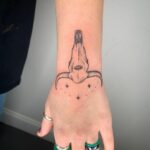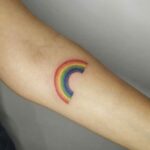Table of Contents
In this post, we’ll peel back the layers, leaving no stone unturned, as we get under the skin (literally and metaphorically) of where tattoos hurt the most and the least. I’ll use my years of experience, hundreds of client stories, and an uncanny ability to make anesthetic-free experiences sound like a Sunday picnic. Whether you’re contemplating your first tattoo or a seasoned ink veteran, I promise you’ll walk away with a heightened understanding of our body’s responses to tattoo placement.

Do you find yourself pondering whether that dream ankle tattoo will have you chewing on your lip, or will the wrist tattoo be a walk in the park? Well, don’t fret. This post is a direct ticket to tattoo enlightenment, blending science with experience, and served with a healthy dollop of Tori’s trademark humor.
Strap in, but not too tightly – remember, it’s all about maintaining the circulation – as we embark on this enlightening journey through your body’s roadmap. Tattoos may sting, but knowledge doesn’t. Welcome to your very own tattoo pain guide, brought to you by yours truly, Tori.
Places Where it Hurts the Most to Get a Tattoo

Before we get into the particulars, it’s essential to note that the most sensitive areas on the body usually hurt the most. This typically includes:
- Feet
- Hands and fingers
- Armpits
- Head
- Inner wrist
- Ribs and chest
Each body is unique, so this isn’t a one-size-fits-all rule. Let’s explore these tattoo pain hotspots:
Feet Tattoo Pain
Feet are an intricate mix of bones wrapped in skin, with not much in the way of fat or muscle. One of my clients once quipped, “It felt like the needle was doodling on the bone itself!” While that might be a smidge dramatic, it does drive home the point: feet tattoos are not for the faint-hearted.

Hands and Finger Tattoo Pain
Ever wondered why celebrities make finger tattoos look so effortless and cool? It’s because they have a battalion of makeup artists to hide the grimace! Hands, with their wealth of nerve endings, are highly sensitive. And despite the popularity of finger tattoos, it’s safe to say they aren’t a joyride.
Armpits Tattoo Pain
Armpit tattoos might sound like a peculiar choice, but they have a unique appeal. Remember Sarah, who popped into my studio last year, itching for an armpit tattoo? She walked out, tattoo and all, declaring, “That was no picnic!” Indeed, with a host of nerves, glands, and lymph nodes, armpit tattoos are a challenging endeavor.
Head Tattoo Pain
Head tattoos – they’re not for the squeamish or those with a low pain tolerance. I’ve heard descriptions ranging from “a bee stinging party” to “someone drilling into the skull.” With minimal fat and abundant nerve endings, the head provides a memorable tattoo experience.
Inner Wrist Tattoo Pain
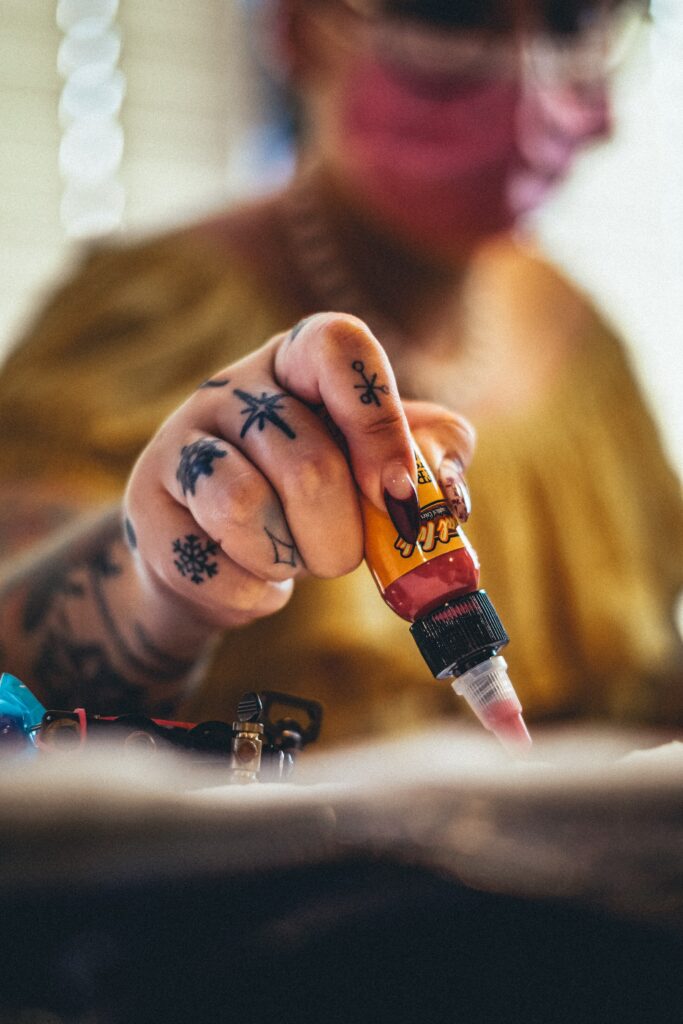
Wrist tattoos, often delicate and deeply personal, pack quite a punch in the pain department. All the visible veins and nerves underneath the thin layer of skin do little to cushion the sting of the needle.
Ribs and Chest Tattoo Pain
Ribs and chest tattoos can be breathtakingly beautiful, but they’re often large pieces involving lots of pain and occasional tears. The movement caused by breathing further intensifies the sensation.
Places That Hurt the Least to Get a Tattoo
Don’t be discouraged! Every body map also has its comfort zones. These areas typically involve abundant fat and muscle:
- Upper back
- Outer arm
- Upper outer thigh
- Butt
- Forearm
- Calves
Let’s dive into these comparatively less painful territories:
Upper Back Tattoo Pain
The upper back, with its generous canvas, is a fantastic choice for larger tattoos. However, a word of caution – try to avoid the spine, and be prepared for a few uncomfortable nights of sleep.
Outer Arm Tattoo Pain
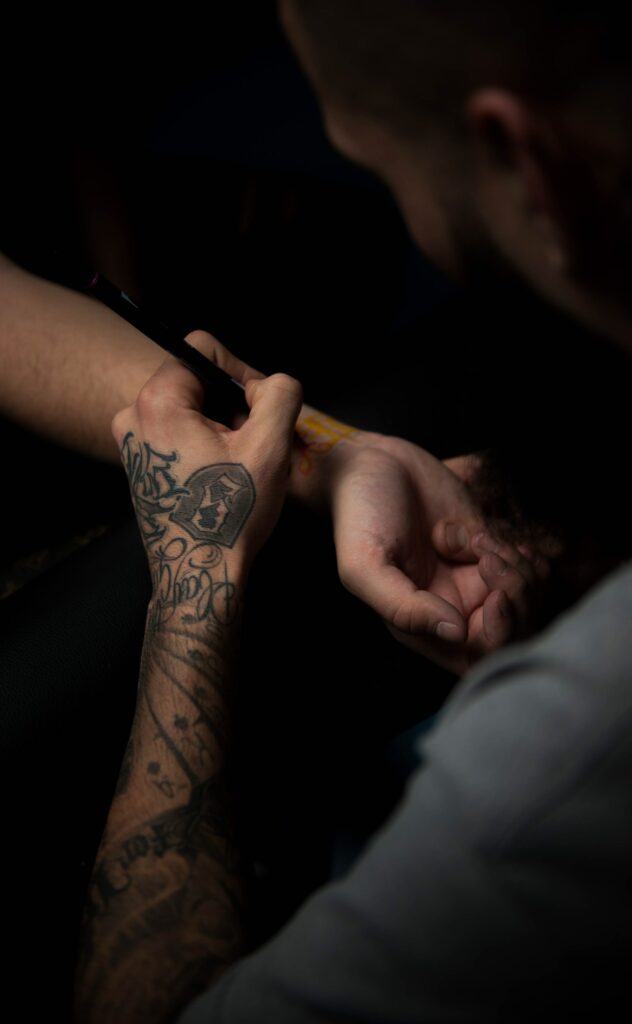
You’ve probably noticed the abundance of sleeve tattoos out there. The upper arm, with its meaty real estate and fewer nerve endings, makes for a relatively smoother tattoo journey.
Upper Outer Thigh Tattoo Pain
The upper outer thigh is your best bet for a low-pain tattoo experience, thanks to its thick skin, ample fat, and sparse nerve endings.
Butt Tattoo Pain
Tattoos on the derrière may invoke giggles, but they’re surprisingly low on the pain scale. Just remember, the healing process might be a bit tricky given its lack of exposure to fresh air.
Forearm Tattoo Pain
Your forearm, with its thick skin and lesser nerve endings, offers a more tolerable tattoo experience. But tread carefully – the wrist region is a whole different ball game.
Calves Tattoo Pain
The calves, with their ample muscle and fat, offer a relatively pain-free zone for tattooing. An added bonus? A generally smooth healing process.
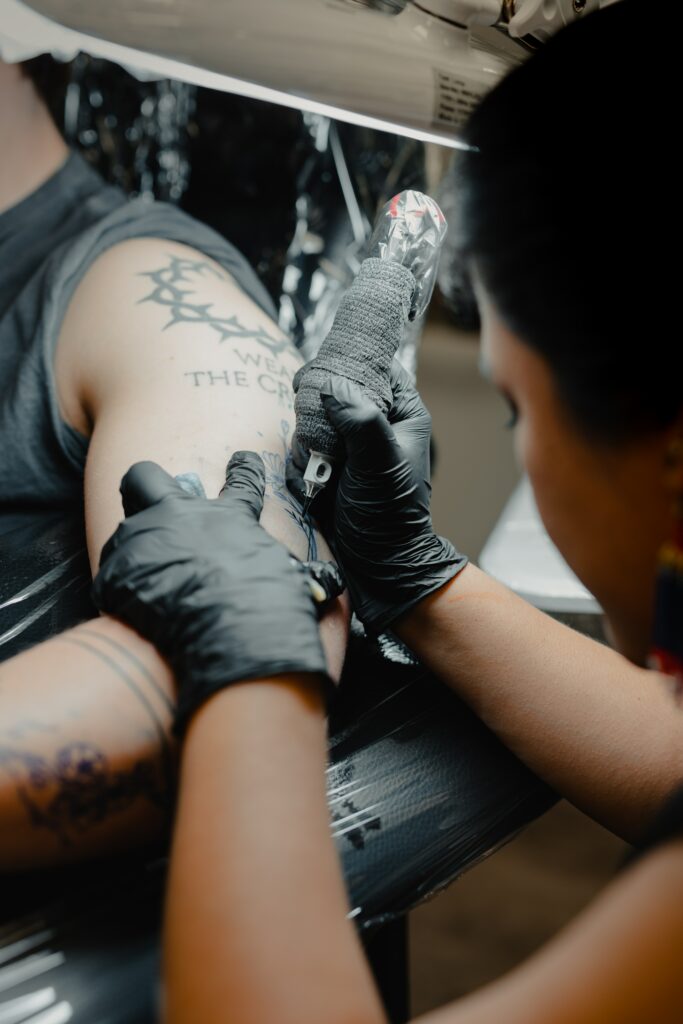
Factors that Affect Pain When Getting a Tattoo
Various elements influence how much a tattoo will hurt. These factors include:
- Placement
- Size and Duration
- Style
- Tattoo Artist
- Pain Threshold
- Mentality
Areas with thicker skin and fat cushion tend to be less painful, while leaner regions can feel more intense. Size and style also matter – larger, more detailed tattoos take longer and hence, involve more discomfort.
Your choice of tattoo artist also plays a role. Remember, a seasoned artist can make a significant difference in your tattoo journey. And let’s not forget personal pain thresholds. Each of us has a unique pain tolerance, which can be influenced by factors like age, gender, and health conditions.
And finally, mindset matters! Try to maintain a positive attitude and remind yourself that it’s just a temporary discomfort for a lifetime of art.
Types of Pain to Expect
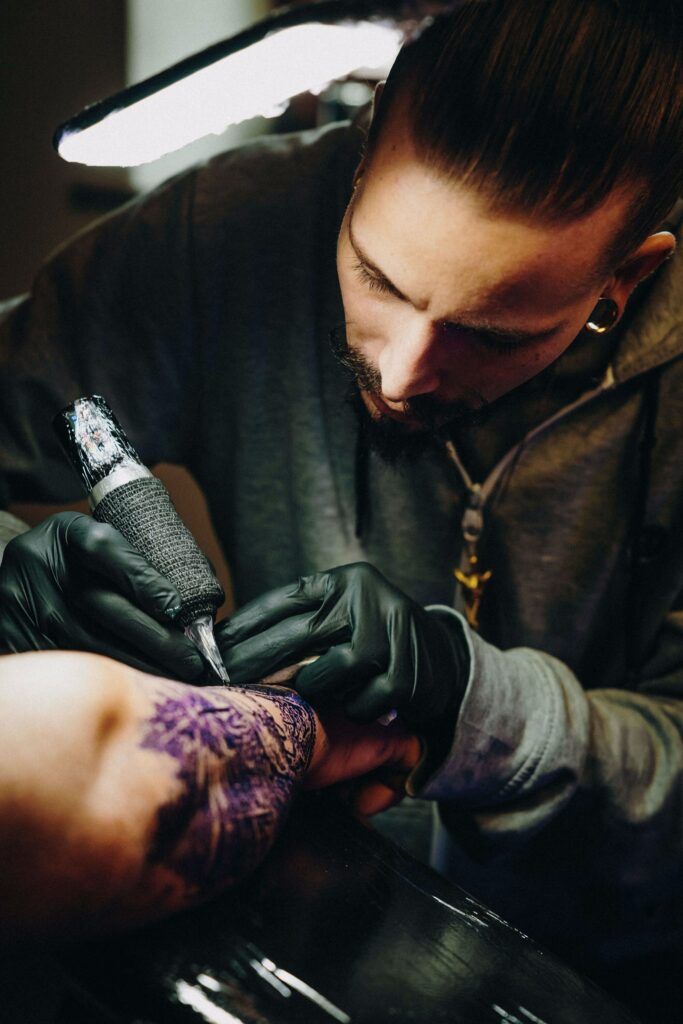
Preparing yourself for a tattoo involves understanding the types of pain associated with it. Let’s get familiar with them:
- Burning Pain: It’s a persistent sensation, like having a heating pad pressed against your skin for too long, usually experienced after lengthy tattoo sessions.
- Sharp Pain: Imagine a bee sting – intense but fleeting. This type of pain is more likely to occur on body parts with thinner skin or if the needle goes too deep.
- Scratching Pain: Often described as a cat endlessly clawing at your skin, this is the most common type of tattoo pain.
Understanding these different types of pain can better prepare you for your tattoo journey. And remember, every tattoo tells a story, and every bit of pain is just a part of your unique tale. Ready to start your ink journey? Reach out, and I’d be thrilled to guide you.
Other Factors That Affect pain during a butt tattoo?
While the location of the tattoo, the tattoo size, and the individual’s pain tolerance are the primary factors affecting pain during a tattoo session, there are several other factors that can contribute as well:
- Tattoo Design: Complex and detailed designs may require different techniques and needle types, which can cause varying levels of pain.
- Ink Color: Sometimes, different colors can cause different levels of discomfort. This is because some colors may require more work (i.e., going over the same area multiple times) to ensure they’re vibrant and fully filled in.
- Health and Wellness: Your overall health, including your skin condition, can influence your experience. Dehydrated, sensitive, or damaged skin may feel more pain. Additionally, being tired, hungover, or ill can lower your pain tolerance.
- Mental State: Anxiety and stress can heighten your sensitivity to pain. Conversely, being relaxed and calm can make the experience more bearable.
- Tattoo Artist’s Experience: An experienced artist knows how to work efficiently, causing less trauma to the skin. Their skill level and approach can have a significant impact on how much pain you feel.
- Aftercare: Not an immediate factor during the tattooing process, but inadequate aftercare can lead to painful complications like infections or prolonged healing.
- Nutrition and Hydration: Being well-nourished and properly hydrated can help your body better cope with the pain.
Remember, each person’s tattoo experience is unique. What may be a mildly uncomfortable process for one individual could be quite painful for another. Preparing yourself mentally and physically can go a long way in ensuring a more comfortable tattoo experience.
Best Products You Can Buy To Help With The Pain
Getting a tattoo involves some level of discomfort, but there are several products on the market that can help to minimize this pain. It’s crucial to always consult with your tattoo artist before using any of these, as some can affect the quality of the tattoo or the tattooing process.
- HUSH Anesthetic Tattoo Numbing Gel: This gel is specifically designed for tattoos. It is a non-oily numbing agent that helps in soothing the skin before the tattooing process.
- Ebanel Numb 520: This is a topical anesthetic cream that can numb the skin quickly and last for a long time, making it a great option for longer tattoo sessions.
- TKTX Numbing Cream: Another popular numbing cream, TKTX is known for its high concentration of numbing agents and long-lasting effects.
- UberNumb Topical Numbing Cream: This cream has lidocaine as its active ingredient and is also infused with Vitamin E to help soothe the skin during the tattooing process.
- Dr. Numb Topical Anesthetic Cream: It’s a well-known brand used widely for numbing the skin for various procedures including tattoos.
- Lidocaine Blue Gel Tattoo Numbing Topical Anesthetic Cream Gel: This product is a gel-based lidocaine numbing agent. It’s easy to apply and is often used by professionals.
- Numb Master 5% Lidocaine Topical Numbing Cream: Fast-acting and long-lasting, this cream is favored by many for its efficiency in numbing the skin prior to a tattoo.
- Greencaine Blast Numbing Cream: Known for its quick numbing action, this cream is suitable for use before and during the tattoo process.
- Aspercreme Pain Relieving Creme With Lidocaine: This is not specifically designed for tattoos but can provide temporary relief of pain associated with the tattoo process.
- Bactine Max Pain Relieving Cleansing Spray: While not a numbing agent, this product cleans and relieves pain and itching in the skin, making it great for aftercare.
Remember, while these products can help reduce the discomfort of getting a tattoo, they don’t completely eliminate the pain.
Conclusion
In the inky world of tattoos, it’s crucial to remember that, yes, it can be a bit painful. However, the pain is transient and it’s a journey that millions have undertaken with pride. Carefully consider your design’s placement, size, and complexity – understand that more nerve-dense and lean areas like feet, hands, and head are usually more sensitive. Conversely, meaty areas like thighs, upper arms, and calves tend to be less painful. Very top-line you can use this table
| Factor | Description |
|---|---|
| Tattoo Size and Detail | Larger, more intricate tattoos require more time, resulting in prolonged needle exposure which can intensify discomfort. |
| Artist Technique | Artists have different tattooing styles and methods. An experienced artist with a softer touch can significantly reduce discomfort. |
| Needle Type and Speed | Different needles cause varying levels of pain. The speed of the artist’s work also matters – faster isn’t necessarily better and might result in more pain. |
| Skin Sensitivity | Different spots within the same general area (the buttocks, in this case) can have varying sensitivities due to differing concentrations of nerve endings. |
| Tattoo Aftercare | The aftercare of a butt tattoo can indirectly contribute to discomfort due to challenges in keeping the area clean and aired out compared to more exposed body parts. |
| Individual Pain Threshold | Pain is subjective. An individual’s pain threshold will greatly affect their perception of discomfort during the tattoo process. |
| Mental Preparedness | Going into the session calm, relaxed, and with a positive mindset can help manage the pain better. Mental preparedness can influence the perception of pain. |
Remember that the pain varies from a tolerable scratch to a momentary sharp sting or a persistent burn. Take your time in selecting an experienced artist and prepare yourself mentally. Pain is subjective and unique to each individual, so don’t let the fear of discomfort hold you back. Your tattoo tells a story that is uniquely yours and the brief discomfort will be worthwhile when you see the artwork that will stay with you forever. Whether you’re already a part of the tattoo community or you’re looking to take your first step, just know that the beauty, the personal expression, the rite of passage – all of it – far outweigh the fleeting pain. So, here’s to creating art and telling stories. One needle, one dot, one line at a time. Ready to wear your heart (or art) on your skin? Let’s do it, together!


